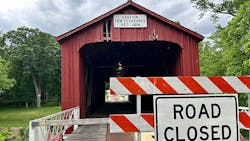Project of the Week: Illinois’ Red Covered Bridge
By Ileana Garnand, Digital Editor
In Northern Illinois, a simple 149-foot wooden bridge attracts visitors from around the world. Or at least it used to — until tragedy struck.
The Red Covered Bridge has been closed for more than a year after a vehicle strike left it severely damaged. The destruction was arguably the worst in the bridge’s long history.
The iconic Red Covered Bridge runs over Big Bureau Creek near Princeton, Ill. The craftmanship used to build the bridge’s wooden decking, siding and roof over 150 years ago is still apparent today.
For locals, the structure has served as the backdrop for countless prom and wedding pictures. It’s inspired artists, photographers and even musicians.
The state landmark is believed to be one of five remaining covered bridges in Illinois. Until recently, it was the only state-owned covered bridge open to traffic and saw an average of 275 vehicles a day.
The Story of the Historic Red Covered Bridge
The original structure was built in 1863 for $3,148.57. A sign on each end warned travelers of a “five dollars fine for driving more than 12 horses, mules, or cattle at any time” or “leading any beast faster than a walk.”
The Red Covered Bridge was added to the U.S. National Register of Historic Places in 1975.
It has survived several threats, including arson, erosion and high winds. Multiple large trucks have also struck the bridge. It was previously hit in 2021, leading the city to add more height and weight restriction signs.
In late 2023, despite said signs, a tractor-trailer truck driver harmed sections of the bridge’s façade and roof while trying to enter its north end. The southern entrance’s original sign was also splintered into pieces.
The vehicle destroyed several overhead support beams, partially collapsing the roof. A temporary bracing has held up the roof and northern walls ever since, marring the bridge’s iconic look.
Repairing the Red Covered Bridge
The Illinois Department of Transportation recently began the first phase of engineering for repairs, which defines the scope of work and produces a preliminary cost estimate.
The second phase will begin as soon as the agency receives approval. It includes a detailed cost estimate, expected to take 12 to 18 months. The department will then offer the repair contract to bidders. It has allocated around $1 million to the endeavor.
“This project represents not only a vital investment in local infrastructure but also a meaningful commitment to preserving a cherished piece of our community’s heritage,” Princeton City Manager Theresa Wittenauer said in a news release.
As repairs continue, questions circle around how to prevent future damage. One potential option is to place bars over the roadways on both sides of the bridge, at the same height of the structure’s clearance. If truck drivers hit the overhead bar, they should know not to continue onto the bridge.
“No one wants to see it be a park area with no traffic like the other covered bridges,” Peter Nelson, Princeton’s zoning administrator, told the Chicago Tribune. “But maybe that’s the reality to preserve the bridge?”
Sources: Illinois Department of Transportation, U.S. National Park Service, Chicago Tribune
